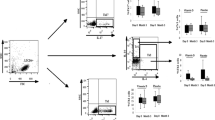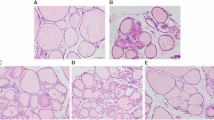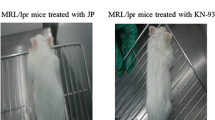Abstract
Objective
To explore the regulatory mechanism of Xiaoyin Recipe (消银方) on the T helper 1/T helper 2 (Th1/Th2) immune balance.
Methods
Thirty-six experimental animals were divided into three groups, 12 rats in each group: blank control group (B group), negative control group (N group), and Xiaoyin Recipe treatment group (T group). The latter two groups received immunization of experimental autoimmune thyroiditis (EAT), and T group were treated with Xiaoyin Recipe for a month. Then, the expression of Th1-Th2-related genes in peripheral blood mononuclear cells (PBMCs) were screened with Oligo GEArray Rat Th1-Th2-Th3 Microarray. The expressions of tumor necrosis factor-α (TNF-α), interleukin-10 (IL-10), T-box expressed in T-cells (T-bet), and GATA-binding protein-3 (GATA-3) were detected by real-time polymerase chain reaction (RT-PCR).
Results
Gene array screening showed that compared to N group, in T group after Xiaoyin Recipe treatment, 3 genes were upregulated in EAT rats, including interleukin-27 receptor alpha (IL-27rα), glomulin (Glmn), and GATA-3, while 38 genes were downregulated, such as CD28, IL-18, signal transducer, and activator of transcription 1 (STAT1), T-bet, TNF receptor superfamily member 4 (TNFRSF4), TNF ligand superfamily member 5 (TNFSF5), and TNF receptor superfamily member 5 (TNFRSF5). While RT-PCR showed that there was an increased level of TNF-α mRNA (P<0.01), an elevated ratio of T-bet/GATA-3, and a decreased level of IL-10 mRNA in PBMC of N and T group compared to B group (P <0.01); and after treatment with Xiaoyin Recipe, IL-10 mRNA level increased (P <0.01), while TNF-α mRNA level and T-bet/GATA-3 ratio decreased in T group compared to N group (P <0.01).
Conclusion
Xiaoyin Recipe for psoriasis could induce a Th1/Th2 balance drift toward Th2 in PBMC of EAT rats and thus improve the conditions.
Similar content being viewed by others
References
Mosmann TR, Cherwinski H, Bond MW, Gieldlin MA, Coffman RL. Two types of murine helper T cell clone. I. Definition according to profiles of lymphokine activities and secreted proteins. J Immunol 1986;136:2348–2357.
Del Prete G. The concept of type-1 and type-2 helper T cells and their cytokines in humans. Int Rev Immunol 1998;16:427–455.
Elenkov IJ. Glucocorticoids and the Th1/Th2 balance. Ann N Y Acad Sci 2004;1024:138–146.
Chen Y, Kuchroo VK, Inobe J, Hafler DA, Weiner HL. Regulatory T cell clones induced by oral tolerance: suppression of autoimmune encephalomyelitis. Science 1994;265:1237–1240.
Nicholson LB, Greer JM, Sobel RA, Lees MB, Kuchroo VK. An altered peptide ligand mediates immune deviation and prevents autoimmune encephalomyelitis. Immunity 1995;3:397–405.
Kidd P. Thl/Th2 balance: the hypothesis, its limitations, and implications for health and disease. Altern Med Rev 2003;8:223–246.
Drugarin D, Negru S, Koreck A, Zosin I, Cristea C. The pattern of a T(H)1 cytokine in autoimmune thyroiditis. Immunol Lett 2000;71:73–77.
Karlsson MG, Ludvigsson J. The ABBOS-peptide from bovine serum albumin causes an IFN-gamma and IL-4 mRNA response in lymphocytes from children with recent onset of type 1 diabetes. Diabetes Res Clin Pract 2000;47:199–207.
Phenekos C, Vryonidou A, Gritzapis AD, Baxevanis CN, Goula M, Papamichail M. Th1 and Th2 serum cytokine profiles characterize patients with Hashimoto’s thyroiditis (Th1) and Graves’ disease (Th2). Neuroimmunomodulation 2004;11:209–213.
Damotte D, Colomb E, Cailleau C, Brousse N, Charreire J, Carnaud C. Analysis of susceptibility of NOD mice to spontaneous and experimentally induced thyroiditis. Eur J Immunol 1997;27:2854–2862.
Austin LM, Ozawa M, Kikuchi T, Walters IB, Krueger JG. The majority of epidermal T cells in psoriasis vulgaris lesions can produce type 1 cytokines, interferon-gamma, interleukin-2, and tumor necrosis factor-alpha, defining TC1 (cytotoxic T lymphocyte) and TH1 effector populations: a type 1 differentiation bias is also measured in circulating blood T cells in psoriatic patients. J Invest Dermatol 1999;113:752–759.
Griffiths CE. The immunological basis of psoriasis. J Eur Acad Dermatol Venereol 2003;17(suppl 2):1–5.
Ghoreschi K, Thomas P, Breit S, Dugas M, Mailhammer R, van Eden W, et al. Interleukin-4 therapy of psoriasis induces Th2 responses and improves human autoimmune disease. Nat Med 2003;9:40–46.
Ghoreschi K, Mrowietz U, Röcken M. A molecule solves psoriasis? Systemic therapies for psoriasis inducing interleukin 4 and Th2 responses. J Mol Med 2003;81:471–480.
Ghoreschi K, Weigert C, Röcken M. Immunopathogenesis and role of T cells in psoriasis. Clin Dermatol 2007;25:574–580.
Zhang H, Xu XG, Gu J. Effect of Xiaoyin Recipe in treatment of psoriasis patients of blood-heat syndrome type and its impact on peripheral Th1/Th2 equilibrium. Chin J Integr Tradit West Med (Chin) 2008;28:683–685.
Rasooly L, Burek CL, Rose NR. Iodine-induced autoimmune thyroiditis in NOD-H-2h4 mice. Clin Immunol Immunopathol 1996;81:287–292.
Tang W, Liu CP, Qin YW, Jia Y, Mao XD, Liu C. Effect of IL-10 gene transmission on the PTg-stimulated splenocytes proliferation and Thl cytokines production from experimental autoimminue thyroiditis rats. J Nanjing Med Univ (Chin) 2007;21:55–58.
Ng HP, Banga JP, Kung AW. Development of a murine model of experimental autoimmune thyroiditis induced with homologous mouse thyroid peroxidase. Endocrinology 2004;145:809–816.
Livak KJ, Schmittgen TD. Analysis of relative gene expression data using real-time quantitative PCR and the 2(-Delta Delta C(T)) method. Methods 2001;25:402–408.
Szegedi A, Aleksza M, Gonda A, Irinyi B, Sipka S, Hunyadi J, et al. Elevated rate of Thelper1 (T(H)1) lymphocytes and serum IFN-gamma levels in psoriatic patients. Immunol Lett 2003;86:277–280.
Jacob SE, Nassiri M, Kerdel FA, Vincek V. Simultaneous measurement of multiple Th1 and Th2 serum cytokines in psoriasis and correlation with disease severity. Mediators Inflamm 2003;12:309–313.
Seifert M, Sterry W, Effenberger E, Rexin A, Friedrich M, Haeussler-Quade A, et al. The antipsoriatic activity of IL-10 is rather caused by effects on peripheral blood cells than by a direct effect on human keratinocytes. Arch Dermatol Res 2000;292:164–172.
Asadullah K, Friedrich M, Hanneken S, Rohrbach C, Audring H, Vergopoulos A, et al. Effects of systemic interleukin-10 therapy on psoriatic skin lesions: histologic, immunohistologic, and molecular biology findings. J Invest Dermatol 2001;116:721–727.
González-Chavez JR, Berlingeri-Ramos AC, Sánchez Casiano MA. Puerto Rico psoriasis study group: efficacy and safety of etanercept. J Drugs Dermatol 2005;4:735–739.
Reich K, Nestle FO, Papp K, Ortonne JP, Evans R, Guzzo C, et al. Infliximab induction and maintenance therapy for moderate-to-severe psoriasis: a phase III, multicentre, double-blind trial. Lancet 2005;366:1367–1374.
Elias AN. Anti-thyroid thioureylenes in the treatment of psoriasis. Med Hypotheses 2004;62:431–437.
Elias AN, Barr RJ. Enhanced apoptosis in psoriatic plaques after treatment with propylthiouracil. Eur J Dermatol 2007;17:353–354.
Strober BE, Siu K, Menon K. Conventional systemic agents for psoriasis. A systematic review. J Rheumatol 2006;33:1442–1446.
Yoshikawa M, Hatakeyama S, Tanaka N, Fukuda Y, Yamahara J, Murakami N. Crude drugs from aquatic plants. I. On the constituents of Alismatis rhizoma. (1). Absolute stereostructures of alisols E 23-acetate, F, and G, three new protostane-type triterpenes from Chinese Alismatis rhizoma. Chem Pharm Bull 1993;41:1948–1954.
Peng GP, Tian G, Huang XF, Lou FC. Guaiane-type sesquiterpenoids from Alisma orientalis. Phytochemistry 2003;63:877–881.
Yamaguchi K, Ida Y, Satoh Y, Nakajima Y, Shoji J. A kaurane derivative isolated from Alisma orientale. Acta Cryst 1994;50:738–740.
Chen YD. Alismataceae. In: Sun XZ, ed. Flora Reipublicae Popularis Sinicae. Vol. 8. Beijing: Science Press; 1992:127–145.
Li WL, Zheng HC, Bukuru J, De Kimpe N. Natural medicines used in the traditional Chinese medical system for therapy of diabetes mellitus. J Ethnopharmacol 2004;92:1–21.
Shin HJ, Kim HJ, Kwak JH, Chun HO, Kim JH, Park H, et al. A prenylated flavonol, sophoflavescenol: A potent and selective inhibitor of cGMP phosphodiesterase 5. Bioorg Med Chem Lett 2002;12:2313–2316.
Zhang Y, Wang S, Li Y, Xiao Z, Hu Z, Zhang J. Sophocarpine and matrine inhibit the production of TNFalpha and IL-6 in murine macrophages and prevent cachexia-related symptoms induced by colon26 adenocarcinoma in mice. Int Immunopharmacol 2008;8:1767–1772.
Zheng YM, Li X, Zhao HY, Zhao JY. Effect of matrine and oxymatrine on proliferation and expression of Stat3 and Stat5 in SMMC-7721 cell line. China J Chin Mater Med (Chin) 2008;33:2234–2237.
Ruwhof C, Drexhage HA. Iodine and thyroid autoimmune disease in animal models. Thyroid 2001;11:427–436.
Allen EM, Bartlett ST. The effect of methimazole, iodine and splenocytes on thyroid transplants in BB/Wor rats. Transplantation 1999;68:25–30.
Ozawa M, Aiba S. Immunopathogenesis of psoriasis. Curr Drug Targets Inflamm Allergy 2004;3:137–144.
Robinson DS, Lloyd CM. Asthma: T-bet-a master controller? Curr Biol 2002;12:322–324.
Finotto S, Glimcher L. T cells directives for transcription regulation in asthma. Springer Semin Immunopathol 2004;25:281–294.
Seki N, Miyazaki M, Suzuki W, Hayashi K, Arima K, Myburgh E, et al. IL-4 induced GATA-3 expression is a time-restricted instruction switch for Th2 cell differentiation. J Immunol 2004;172:6158–6166.
Szabo SJ, Kim ST, Costa GL, Zhang XK, Fathman CG, Glimcher LH, et al. A novel transcription factor, T-bet, directs Th1 lineage commitment. Cell 2000;100:655–669.
Chakir H, Wang HP, Lefebvre DE, Webb J, Scott FW. T-bet/GATA-3 ratio as a measure of the Th1/Th2 cytokine profile in mixed cell populations: predominant role of GATA-3. J Immunol Methods 2003;278:157–169.
Author information
Authors and Affiliations
Corresponding author
Rights and permissions
About this article
Cite this article
Xu, Xg., Zhang, H., Bi, Xl. et al. Xiaoyin Recipe (消银方) for psoriasis induces a Th1/Th2 balance drift toward Th2 in peripheral blood mononuclear cells of experimental autoimmune thyroiditis rats. Chin. J. Integr. Med. 18, 137–145 (2012). https://doi.org/10.1007/s11655-012-0995-0
Received:
Published:
Issue Date:
DOI: https://doi.org/10.1007/s11655-012-0995-0




